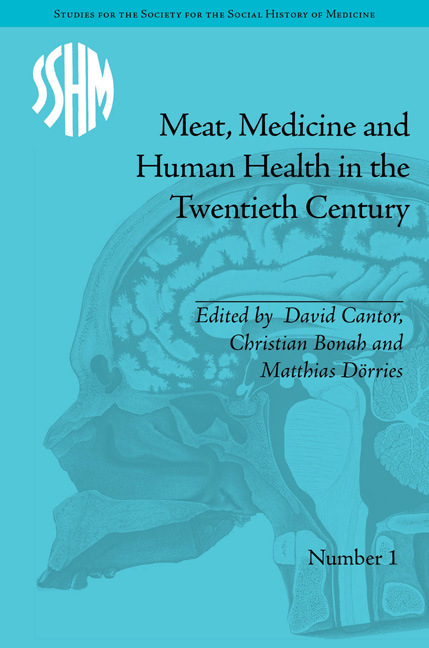Book contents
- Frontmatter
- CONTENTS
- Acknowledgements
- List of Contributors
- List of Figures and Tables
- Introduction
- Part 1 Meat and Therapeutics
- 1 Zomine: A Tale of Raw Meat, Tuberculosis, Industry and War in Early Twentieth Century France
- 2 Treat with Meat: Protein, Palatability and Pernicious Anaemia in the 1920s–30s
- 3 How Abattoir ‘Biotrash’ Connected the Social Worlds of the University Laboratory and the Disassembly Line
- Part II Meat, Politics and Culture
- Part III Meat, Risk and Regulation
- Notes
- Index
1 - Zomine: A Tale of Raw Meat, Tuberculosis, Industry and War in Early Twentieth Century France
from Part 1 - Meat and Therapeutics
- Frontmatter
- CONTENTS
- Acknowledgements
- List of Contributors
- List of Figures and Tables
- Introduction
- Part 1 Meat and Therapeutics
- 1 Zomine: A Tale of Raw Meat, Tuberculosis, Industry and War in Early Twentieth Century France
- 2 Treat with Meat: Protein, Palatability and Pernicious Anaemia in the 1920s–30s
- 3 How Abattoir ‘Biotrash’ Connected the Social Worlds of the University Laboratory and the Disassembly Line
- Part II Meat, Politics and Culture
- Part III Meat, Risk and Regulation
- Notes
- Index
Summary
In 1900 the French physiologist Charles Richet published a short paper which reported that a raw meat diet could cure tuberculosis. The paper originated in a semi-accidental observation: a rapid improvement in the health of tuberculosis-infected dogs, fed with a large quantity of uncooked meat. Since the 1890s, Richet and his colleague, Jules Héricourt had tried to cure tuberculosis with a wide range of antiseptics and other substances. These experiments, conducted in a rather chaotic way, did not produce results, until Richet and Héricourt's tuberculosis-infected dogs recovered. This was the starting point for Richet's attempts to develop a raw-meat-based treatment against tuberculosis and related pathological conditions.
In developing his ‘meat therapy’, Richet followed the steps of an earlier famous scientist, the German chemist and physiologist, Justus von Liebig (1803–73), one of the pioneers of modern theories of nutrition. In 1840, Liebig had developed a beef extract marketed under his name, building on a longer tradition which viewed meat as a major strength-providing substance, able to restore health. At least since the work of the French inventor, Denis Papin in the 1680s, physicians had proposed using meat extracts to increase the health of the working classes. Liebig added his scientific authority to this view, and his meat extract came to be considered a borderline product, part food and part drug. What Liebig proposed was that it should be given to soldiers to improve their resilience and fighting capacity, and to sick people to help their recovery.
- Type
- Chapter
- Information
- Meat, Medicine and Human Health in the Twentieth Century , pp. 33 - 46Publisher: Pickering & ChattoFirst published in: 2014



